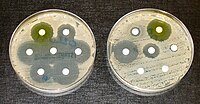
Photo from wikipedia
Abstract Background Antimicrobial resistance (AMR) surveillance is critical in informing strategies for infection control in slowing the spread of resistant organisms and for antimicrobial stewardship in the care of patients.… Click to show full abstract
Abstract Background Antimicrobial resistance (AMR) surveillance is critical in informing strategies for infection control in slowing the spread of resistant organisms and for antimicrobial stewardship in the care of patients. However, significant challenges exist in timely and comprehensive AMR surveillance. Methods Using BioFire Pneumonia and Blood Culture 2 Panels data from BioFire Syndromic Trends (Trend), a cloud-based population surveillance network, we described the detection rate of AMR among a US cohort. Data were included from 2019 to 2021 for Gram-positive and -negative organisms and their related AMR genomic-resistant determinants as well as for detections of Candida auris. Regional and between panel AMR detection rate differences were compared. In addition, AMR codetections and detection rate per organism were evaluated for Gram-negative organisms. Results A total of 26 912 tests were performed, primarily in the Midwest. Overall, AMR detection rate was highest in the South and more common for respiratory specimens than blood. methicillin-resistant Staphylococcus aureus and vancomycin-resistant Enterococcus detection rates were 34.9% and 15.9%, respectively, whereas AMR for Gram-negative organisms was lower with 7.0% CTX-M and 2.9% carbapenemases. In addition, 10 mcr-1 and 4 C auris detections were observed. For Gram-negative organisms, Klebsiella pneumoniae and Escherichia coli were most likely to be detected with an AMR gene, and of Gram-negative organisms, K pneumoniae was most often associated with 2 or more AMR genes. Conclusions Our study provides important in-depth evaluation of the epidemiology of AMR among respiratory and blood specimens for Gram-positive and -negative organism in the United States. The Trend surveillance network allows for near real-time surveillance of AMR.
Journal Title: Open Forum Infectious Diseases
Year Published: 2022
Link to full text (if available)
Share on Social Media: Sign Up to like & get
recommendations!